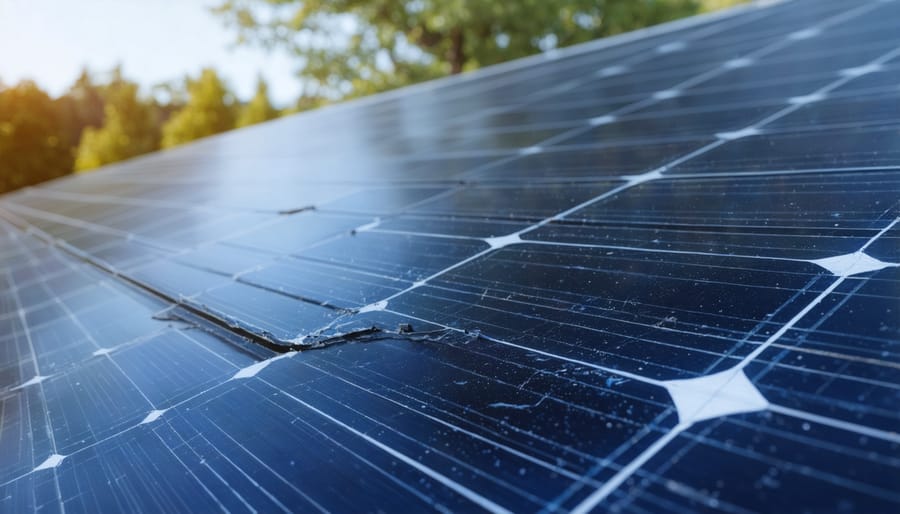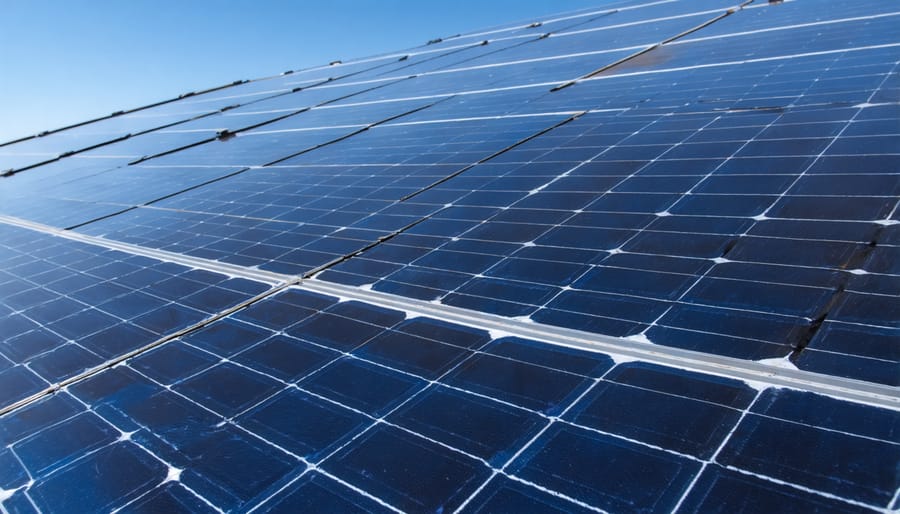Inspect your solar installation for exposed edges and vulnerable mounting points where wind can create uplift forces, particularly if your panels sit on a low-slope roof or face prevailing westerly winds common across coastal BC. Solar panel wind deflectors act as aerodynamic barriers that redirect wind flow around and over your array, reducing the pressure differential that causes panels to lift, loosen, or sustain structural damage during storms.
Calculate whether your location requires additional wind protection by checking if you’re in a high-wind zone—areas near the Strait of Georgia, exposed hilltops in the Interior, or coastal communities regularly experiencing gusts above 90 km/h warrant serious consideration. Wind deflectors typically install along the leading edge of your solar array, creating a ramp that forces air upward rather than allowing it to catch underneath panels.
Most BC solar owners who’ve added deflectors report significant reductions in wind noise and movement during winter storms, with some Vancouver Island installations crediting the devices with preventing costly damage during recent extreme weather events. The investment typically ranges from $200 to $800 depending on array size, making it considerably more affordable than repairing wind-damaged panels or addressing roof membrane tears caused by panel movement.
Work with certified installers who understand BC’s specific wind load requirements and can assess whether your existing mounting system needs reinforcement alongside deflector installation. This proactive approach protects both your solar investment and your roof structure while maintaining optimal panel performance throughout our region’s diverse weather patterns.
The Real Cost of Wind Damage to Solar Installations

How BC’s Weather Patterns Put Extra Stress on Your Panels
British Columbia’s diverse geography creates unique wind challenges that solar panel owners should understand. Along the coast, powerful Pacific storms bring sustained winds exceeding 90 km/h, combined with salt air that can corrode mounting systems over time. These weather events place significant lateral stress on panel arrays, particularly those installed on residential rooftops near the ocean.
In the Fraser Valley, strong outflow winds funnel through the mountain passes, creating localized wind tunnels that can generate unexpected uplift forces beneath solar panels. These winds often arrive with little warning during winter months, catching homeowners off guard. One Chilliwack resident discovered minor frame damage after a particularly intense outflow event, highlighting the importance of proper wind protection.
The interior regions face their own challenges, with mountain winds creating turbulent conditions that vary dramatically by elevation and terrain. Kelowna and Kamloops installations often experience gusty conditions that test the durability of standard mounting systems.
Understanding your region’s specific wind patterns helps you make informed decisions about whether wind deflectors are a worthwhile investment. Local solar installers familiar with BC’s microclimates can assess your property’s exposure and recommend appropriate protective measures tailored to your location’s weather realities.
What Solar Panel Wind Deflectors Actually Do

Types of Wind Deflectors for Different Installation Setups
Wind deflectors come in several configurations to match different solar panel setups, and choosing the right type depends on your installation method and local wind patterns.
For rooftop installations, low-profile deflectors are the most common choice across BC. These attach directly to your roof’s edge or integrate with existing mounting hardware, redirecting wind up and over your panels. They work particularly well on sloped roofs where wind naturally flows upward. Many homeowners in coastal communities like Victoria and Nanaimo opt for transparent acrylic deflectors that maintain their home’s appearance while providing protection during fall and winter storms.
Ground-mounted installations require sturdier deflector systems since they face wind from multiple directions. Perimeter wind barriers or strategically placed fence-style deflectors create protected zones around your solar array. These systems are popular in Fraser Valley farms and interior regions where open terrain means fewer natural windbreaks. The key is positioning deflectors to channel prevailing winds without creating turbulence.
Commercial installations on flat roofs typically use ballasted deflector systems that don’t require roof penetration. These weighted barriers sit along vulnerable edges and can be adjusted seasonally based on BC’s shifting wind patterns. Many Vancouver-area businesses combine deflectors with their existing parapet walls for enhanced protection.
When selecting deflectors, consider your location’s specific wind challenges. Coastal properties benefit from corrosion-resistant materials like marine-grade aluminum, while interior locations might prioritize deflectors that handle snow accumulation alongside wind protection. Your local installer can recommend solutions tailored to your site’s conditions.
When Your BC Solar Installation Needs Wind Protection
High-Risk Zones Across British Columbia
Certain BC communities face distinctly higher wind-related risks for solar installations due to their unique geography and weather patterns. In Squamish, powerful outflow winds funneling through the coastal mountains can exceed 100 km/h, making wind deflectors essential for panels installed on exposed rooftops or ground mounts. The town’s renewable energy enthusiasts have learned this lesson firsthand, with several early installations requiring costly repairs before deflectors became standard practice.
Kelowna presents different challenges. The Okanagan Valley experiences intense summer storms with sudden wind gusts that can lift improperly secured panels. Local installers now routinely recommend deflectors for rooftop systems, particularly on homes positioned on hillsides where wind acceleration occurs.
Prince George’s northern location brings year-round wind exposure combined with heavy snow loads. Here, deflectors serve double duty by reducing wind uplift while helping prevent ice dam formation along panel edges. Homes in exposed subdivisions or rural properties without natural windbreaks benefit most from this protection.
Coastal communities from Victoria to Prince Rupert face persistent westerly winds, especially during winter storms. Agricultural properties with ground-mounted arrays in open fields represent particularly high-risk scenarios across all regions, as they lack structural wind protection entirely.
Real BC Stories: Wind Deflectors in Action
Real BC families and businesses have seen measurable benefits after adding wind deflectors to their solar installations. Here are three stories from our community that show how this simple upgrade protected investments and delivered peace of mind.
The Kamloops Ridge Residential Solution
Sarah and Tom Chen installed a 6kW solar array on their Kamloops hillside home in 2021. After their first winter, they noticed edge panels were lifting slightly during wind storms common to their exposed location. Rather than wait for potential damage, they worked with their installer to add aluminum wind deflectors around the array perimeter.
The cost was $850, and the difference was immediate. During a severe windstorm six months later that saw gusts reach 90 km/h, their neighbors’ unsecured patio furniture scattered, but the solar panels stayed firmly in place. Two years later, the Chens report no wind-related issues and estimate they avoided at least $2,000 in potential panel replacement costs.
Lesson learned: If you live in an exposed area, adding deflectors during installation saves money compared to retrofitting later.
Whistler Commercial Installation Success
Mountain View Lodge, a 40-room hotel in Whistler, installed a 25kW rooftop solar system in 2020. Given the location’s notorious wind conditions, their installer recommended integrated wind deflectors from the start. The additional upfront cost was $3,200.
During the first three years of operation, the property manager documented wind events exceeding 80 km/h on 15 occasions. Meanwhile, a neighboring property without deflectors experienced panel movement requiring two service calls and temporary system shutdowns. Mountain View Lodge has had zero wind-related maintenance issues.
The takeaway: For commercial installations in high-wind areas, deflectors aren’t optional; they’re essential infrastructure that prevents costly downtime.
These BC examples demonstrate that wind deflectors offer real protection and tangible returns, particularly in our province’s diverse climate zones.

Making the Investment: Costs and Installation
Working With Your Solar Installer on Wind Protection
Whether you’re planning a new solar installation or considering wind protection as an upgrade, open communication with your installer is essential. During initial consultations, ask about wind assessment for your specific location—coastal and mountain properties face unique challenges. Request information about deflector compatibility with your panel model and roof type, and inquire whether they’ve worked on similar projects in BC’s diverse weather zones.
For professional installation, certified installers should provide wind load calculations and explain how deflectors integrate with your existing mounting system. Ask about warranty implications, as some manufacturers require specific installation methods to maintain coverage. Expect a site visit where installers evaluate roof pitch, prevailing wind direction, and potential turbulence from nearby structures or trees.
If retrofitting, your installer will assess whether your current racking system can accommodate deflectors without modifications. The process typically takes a few hours for standard residential installations. Request before-and-after performance monitoring to verify the deflectors aren’t creating shading issues. Many BC installers now offer wind protection consultations as standard practice, reflecting our region’s growing understanding of weather-related solar challenges.
Other Weather Protection Measures That Work Together
Wind deflectors work best as part of a complete weather protection strategy for your solar installation. Think of your panels like a house—they need multiple layers of protection to withstand BC’s diverse climate conditions.
Proper mounting systems form your foundation. They secure panels firmly to your roof structure, distributing wind loads evenly and preventing uplift during storms. Quality mounting hardware designed for your specific roof type makes all the difference in long-term durability.
Snow guards complement wind deflectors by preventing dangerous snow slides off your panels. This is particularly important for sloped roofs in areas like the Interior and North, where heavy snowfall can create hazards below.
Effective drainage systems ensure water flows away from panel edges and mounting points, preventing ice buildup that can stress your system during freeze-thaw cycles. Strategic panel placement considers prevailing wind direction and potential debris sources like nearby trees.
When these elements work together with wind deflectors, you create comprehensive protection that extends your system’s lifespan and maintains optimal energy production year-round, maximizing your solar investment.
For BC solar owners, wind deflectors represent a smart, preventative measure that protects your clean energy investment from our region’s challenging weather conditions. As we’ve explored, coastal winds and mountain gusts can compromise even well-installed systems, leading to repair costs that far exceed the price of proper wind protection. The evidence from Richmond, Squamish, and Vancouver Island demonstrates that a modest upfront investment in wind deflectors can prevent thousands of dollars in damage while maintaining your system’s energy production.
Whether you’re planning a new installation or evaluating an existing array, now is the time to assess your property’s wind exposure and determine if additional protection makes sense. Solar BC offers comprehensive tools to help you evaluate your installation site and understand the factors that affect system performance and longevity. Our network of certified installers across British Columbia can provide professional assessments tailored to your specific location and conditions.
Don’t wait for wind damage to force your hand. Connect with Solar BC’s certified installers today for a thorough evaluation of your solar system’s wind resilience. Together, we can ensure your renewable energy investment continues delivering clean power for decades to come while contributing to BC’s sustainable energy future.

